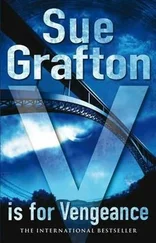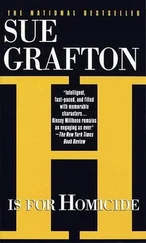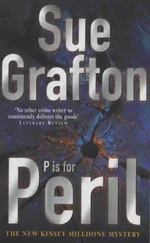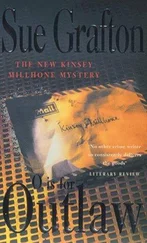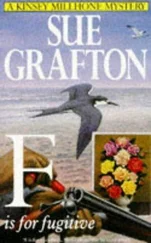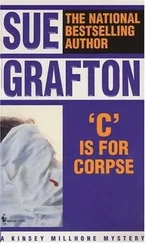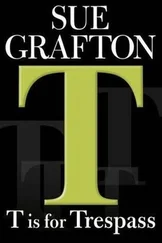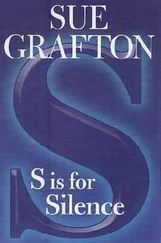A swath of green lawn sloped upward toward the house, the long paved driveway forming a half-circle as it curved down and touched the road again. The Kirkendalls’ former residence was a one-story structure in the shape of an inverted L, with the short arm extended toward the street. The exterior of the house was red brick and darkly stained redwood with bold horizontal lines and generous expanses of glass. The flat concrete roof formed a wide overhang that shaded the verandah along the front. There were no flourishes, no embellishments, and no unnecessary touches.
“This can’t be right,” Sutton said.
“Yes, it is. In 1967, there was only one Kirkendall in town and this is where they lived.”
“But where’s the second floor? Billie Kirkendall was sick. He stayed upstairs and I stayed down.”
“Oh, shit. I’d forgotten that. Wait here and I’ll see if the owner’s home. Maybe we can get permission to explore.”
I got out of the car and dog-trotted across the road. The driveway didn’t appear steep, but I was winded by the time I reached the top. The place had an air of emptiness, a house enveloped in quiet. The windows were bare and there was no sign of a doormat or any of the homely touches that indicate someone in residence. A band of damp paving along the front suggested that the sprinklers were still active, probably governed by the same automatic program that regulated indoor temperatures and turned lights off and on. I went up a low step to the entrance, where a panoramic wall of glass afforded me an unobstructed view of the interior.
The architect had kept the non-load-bearing walls to a minimum and the blond hardwood floors seemed to stretch in all directions. Light poured in from everywhere. A stone fireplace was offset on the far wall and I could see a length of kitchen counter that had been stripped of small appliances. To the right was the empty dining room, with a low-hanging light fixture centered in the ceiling. I walked to my right along the verandah, where I could see a large bedroom with white wall-to-wall carpeting and mirrored sliding doors, one partially open to reveal cavernous closet space.
I returned to the front door and noticed for the first time an alarm company decal saying ARMED RESPONSE pasted to one corner of the glass. The warning was probably more form than content. It seemed unlikely that anyone would pay for security services when the house stood empty. I was assuming the property was on the market, but there was no realtor’s lockbox and no stack of brochures detailing the floor plan, the square footage, or the number of rooms. For Sale signs were prohibited by the home owners’ association. For all I knew, every house in Horton Ravine was up for grabs. I rang the bell with no expectation of a response.
I left the porch, intending to circle the premises. Sutton must have been clued in to the fact that the house was vacant because he emerged from the Mustang and crossed the road as I had. I waited while he climbed the drive and then the two of us traced a path around the house to the rear. Below, on a wide concrete apron, there was a swimming pool and cabana surrounded on two sides by a plain concrete wall with an outdoor fireplace and built-in barbecue pit. Sutton turned and looked at the rear elevation. From this vantage point, the two-story construction was evident. The house had been tucked in against the steep hill and a series of windows looked out on the view. Beyond the patio, the property sloped down again sharply and thick railroad ties had been cut into the hillside to form a crude staircase. The neighbors’ rooftops floated like rafts on a lake of dark green treetops.
“Look familiar?”
“I guess. I thought the house was much bigger.”
“A lot of things look bigger when you’re six.”
“There wasn’t a swimming pool. I’d have remembered it.”
“I’ve done the research and this is where you were. The pool and barbecue could have been added later,” I said. “Let’s take a walk down the hill. If you wandered, that would have been your only choice.”
The brush had been cleared within a twenty-foot radius along the slope, probably by order of the fire department. Sutton followed me reluctantly as I crossed the grass and made my descent. There was no handrail and the steps themselves were deep, with ten-inch risers that forced us to descend the stairs like toddlers, putting both feet on every step before moving to the next. This portion of the lot was useless to all intents and purposes. A series of terraces had been carved out of the hill. The first level was planted with dwarf fruit trees. The second offered shelter in a weathered wood pagoda lined with benches and bleached by the elements to a soft silver gray. The third was given over to rose beds that, at this point, were sadly neglected.
After that, the land fell away gradually. The bottom of the hill butted into a grove of trees that stretched out on either side, in varying degrees of density. I counted three large oaks and six mature black acacias. Clusters of pittosporum and eucalyptus were intermingled with saplings. I wouldn’t have called this “the woods,” but to Sutton, at the age of six, it might have looked like one. Where the undergrowth was thin, I could see sections of a paved road that must have been Via Juliana, one of the primary arteries through Horton Ravine. If I’d been searching for a secluded location to serve as a grave site, I wouldn’t have picked this. From above, the hillside was open to view. Given the staggered pattern of trees below, the area would have been visible from the road as well.
Sutton stood there, his hands in his pants pockets, his gaze moving across the landscape as he struggled to get his bearings. I could see his confusion now that he was faced with a scene that had seemed so vivid in his mind. He moved to his right, traipsing through knee-high weeds before he came to a standstill. A fence blocked his path, the chicken wire sagging under a swarm of morning glory vines. The sign affixed to the fence post read:
DO NOT TRESPASS
Private Property Keep Out
No Access to Bridle Trail
THIS MEANS YOU!!
He walked up the hill for a distance, peering at the trees in range of him. He stopped again and shook his head. “This is all wrong. I don’t see the tree I used as a hideout and I don’t see the oak I hid behind when I was spying on the guys.”
“Maybe the oak was cut down.”
“But the fence is wrong, too. Where did that come from? I didn’t climb a fence. I’m sure of it. This is all screwed up.”
“Sutton, it’s been years. Take your time.”
He shook his head in frustration.
“Would you quit being so negative?” I said.
“I’m not negative.”
“You are, too. You should listen to yourself.”
He turned and scanned the woods again, no happier than he’d been. The guy was getting on my nerves. I watched while he walked down the hill toward the trees. I followed the sagging fence line as he had, but where he went down the hill, I climbed up. A profusion of wildflowers had sprung up among the grasses. Grasshoppers skittered ahead of me as I walked. I turned and looked back as Sutton disappeared into the trees.
Below and to my right, I caught a glimpse of the rear of a house: patio doors, a deck, an outdoor table and chairs. Since I wasn’t well acquainted with the neighborhood, I couldn’t judge the relationships between properties. The irregular course the fence had taken suggested it had been erected in conformity with a meandering lot line, separating the parcel that fronted Ramona Road from the one that faced the secondary road below. Dimly I remembered the fork where a smaller tributary split off from Via Juliana. From where I stood, only the one house was visible, but there were doubtless others on that same street.
Читать дальше

